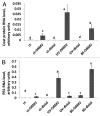Perception of volatiles produced by UVC-irradiated plants alters the response to viral infection in naïve neighboring plants
- PMID: 22751319
- PMCID: PMC3583953
- DOI: 10.4161/psb.20406
Perception of volatiles produced by UVC-irradiated plants alters the response to viral infection in naïve neighboring plants
Abstract
Interplant communication of stress via volatile signals is a well-known phenomenon. It has been shown that plants undergoing stress caused by pathogenic bacteria or insects generate volatile signals that elicit defense response in neighboring naïve plants. Similarly, we have recently shown that naïve plants sharing the same gaseous environment with UVC-exposed plants exhibit similar changes in genome instability as UVC-exposed plants. We found that methyl salicylate (MeSA) and methyl jasmonate (MeJA) serve as volatile signals communicating genome instability (as measured by an increase in the homologous recombination frequency). UVC-exposed plants produce high levels of MeSA and MeJA, a response that is missing in an npr1 mutant. Concomitantly, npr1 mutants are impaired in communicating the signal leading to genome instability, presumably because this mutant does not develop new necrotic lesion after UVC irradiation as observed in wt plants. To analyze the potential biological significance of such plant-plant communication, we have now determined whether bystander plants that receive volatile signals from UVC-irradiated plants, become more resistant to UVC irradiation or infection with oilseed rape mosaic virus (ORMV). Specifically, we analyzed the number of UVC-elicited necrotic lesions, the level of anthocyanin pigments, and the mRNA levels corresponding to ORMV coat protein and the NPR1-regulated pathogenesis-related protein PR1 in the irradiated or virus-infected bystander plants that have been previously exposed to volatiles produced by UVC-irradiated plants. These experiments showed that the bystander plants responded similarly to control plants following UVC irradiation. Interestingly, however, the bystander plants appeared to be more susceptible to ORMV infection, even though PR1 mRNA levels in systemic tissue were significantly higher than in the control plants, which indicates that bystander plants could be primed to strongly respond to bacterial infection.
Figures




Similar articles
-
UV-C-irradiated Arabidopsis and tobacco emit volatiles that trigger genomic instability in neighboring plants.Plant Cell. 2011 Oct;23(10):3842-52. doi: 10.1105/tpc.111.089003. Epub 2011 Oct 25. Plant Cell. 2011. PMID: 22028460 Free PMC article.
-
Increase in recombination rate in Arabidopsis thaliana plants sharing gaseous environment with X-ray and UVC-irradiated plants depends on production of radicals.Plant Signal Behav. 2012 Jul;7(7):782-7. doi: 10.4161/psb.20571. Epub 2012 Jul 1. Plant Signal Behav. 2012. PMID: 22751301 Free PMC article.
-
Salicylic acid-dependent expression of host genes in compatible Arabidopsis-virus interactions.Plant Physiol. 2005 Mar;137(3):1147-59. doi: 10.1104/pp.104.056028. Epub 2005 Feb 22. Plant Physiol. 2005. PMID: 15728340 Free PMC article.
-
Local infection with oilseed rape mosaic virus promotes genetic rearrangements in systemic Arabidopsis tissue.Mutat Res. 2011 May 10;709-710:7-14. doi: 10.1016/j.mrfmmm.2011.02.014. Epub 2011 Mar 3. Mutat Res. 2011. PMID: 21376739
-
Threat at One End of the Plant: What Travels to Inform the Other Parts?Int J Mol Sci. 2021 Mar 19;22(6):3152. doi: 10.3390/ijms22063152. Int J Mol Sci. 2021. PMID: 33808792 Free PMC article. Review.
Cited by
-
A systemic increase in the recombination frequency upon local infection of Arabidopsis thaliana plants with oilseed rape mosaic virus depends on plant age, the initial inoculum concentration and the time for virus replication.Front Plant Sci. 2013 Mar 21;4:61. doi: 10.3389/fpls.2013.00061. eCollection 2013. Front Plant Sci. 2013. PMID: 23519399 Free PMC article.
-
Plant Science View on Biohybrid Development.Front Bioeng Biotechnol. 2017 Aug 14;5:46. doi: 10.3389/fbioe.2017.00046. eCollection 2017. Front Bioeng Biotechnol. 2017. PMID: 28856135 Free PMC article. Review.
-
Insights into the Mechanisms Underlying Ultraviolet-C Induced Resveratrol Metabolism in Grapevine (V. amurensis Rupr.) cv. "Tonghua-3".Front Plant Sci. 2016 Apr 19;7:503. doi: 10.3389/fpls.2016.00503. eCollection 2016. Front Plant Sci. 2016. PMID: 27148326 Free PMC article.
References
Publication types
MeSH terms
Substances
Grants and funding
LinkOut - more resources
Full Text Sources
Molecular Biology Databases
Miscellaneous
